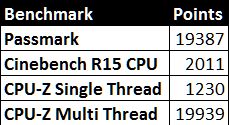This is the jaw-dropping CPU almost no one wants you to buy
Kaby Lake? No, it's a Xeon and it's old

In the history of processing power, faster didn't always quench the need for speed which is why multi-threading, multi-core and multi-socket solutions were introduced, first at the very top-end of the market and more recently to consumers.
Having more of everything does help to speed up performance even if it's not always a 'linear' boost (i.e. adding two processors doesn't automatically double the speed).
More often than not, it depends on other factors like the operating system (how well does it support multi-threading/multi-core?) and the applications that will use that raw firepower (can they take advantage of more than one core?).
Keeping many cores unused is a bit like under-using a powerful jet engine: even idling, it still consumes a lot of fuel.
Most computers (and almost all laptops) have processors with two cores (for the sake of simplicity we won't talk about smaller/less powerful Atom-based devices, or those based on ARM chips).
Unfortunately, while computers with one physical processor are relatively cheap, those with two are a rather expensive outlay and are usually limited to servers and workstations.
However, at the end of last year, something happened; one or more cloud giants (think Facebook, Google, Amazon or Microsoft) decommissioned a fair number of servers and flooded the second-hand, used and refurbished market with high-end Intel Xeon processors which usually cost hundreds if not thousands of pounds.
Sign up to the TechRadar Pro newsletter to get all the top news, opinion, features and guidance your business needs to succeed!
Auction action
The result? eBay is full of Xeon E5 processors at the moment, the cheapest models being the E5-2660 which can be had for around £40 (or $40). If you are an enthusiast and don't mind experimenting, grab them while they are available as stocks won't last forever.
While they do not come with a warranty because of their age, they usually have a DOA (dead on arrival) clause which forces the seller to provide a replacement in case of failure; plus, at the price, you might get a few anyway and stock up with them.
And what you do get is a powerful processor that blitzes anything in this price range. With eight cores, 16 threads, 20MB cache and a 2.2GHz base speed, this Sandy Bridge-based CPU will run circles around the competition, punching well above its weight.
How far above said weight? We managed to get a system based on the slightly more powerful E5-2670 from specialist refurbisher, Bargainhardware.
The system is a refurbished workstation (Lenovo Thinkstation D30) that costs around £1,700 (about $2,300, AU$3,000) when kitted out with a couple of Xeon CPUs, 64GB RAM, an Nvidia Quadro 600 graphics card, a 150GB Velociraptor drive and a 2TB storage disk.

Yes, that's expensive, but then, it is not dearer than some of Intel's own Core i7 processors like the 6950X (while performing marginally slower on pure core-sensitive tasks), and only marginally more expensive than some entry-level workstations.
Our workstation came with 32GB of RAM, an old AMD/ATI FirePro V7370 graphics card, a 120GB SSD and Windows 7 Pro.
You can, of course, build your very own workstation but opting for a pre-configured one saves the hassle of choosing compatible parts and shoving them all together.
That means selecting the right motherboard (two LGA2011 sockets), the right amount of memory (always in multiples of four, ECC type preferably), a solid power supply unit capable of handling all the components, adequate cooling and ventilation, and a case to accommodate all this.
Blistering benchmarks
We briefly tested the D30 workstation with three mainstream benchmarks (Passmark, CPU-Z and Cinebench R15) and it came as no surprise that the combined 16 cores breezed through all of them with some stunning numbers.

Note that all of the tests were CPU-focused because the graphics card is an obsolete model. The two CPUs combined to produce a Passmark performance of nearly 19,400 points which easily puts the pair in the top 20 all-time performers.
But such a system won't be for everyone as it misses out on newer technologies (no out-of-the-box support for M2 format for example) and offers almost no upgrade route.
The D30, for example, has only a couple of USB 3.0 ports, weighs a ton (27kg to be precise) and older processors will consume more power than newer ones.
However, if you do a lot of video editing, encoding or anything that requires a lot of CPU resources AND supports multi-core systems, you would be very hard pressed to find anything that can better a pair of old but still very capable Xeon CPUs.

Désiré has been musing and writing about technology during a career spanning four decades. He dabbled in website builders and web hosting when DHTML and frames were in vogue and started narrating about the impact of technology on society just before the start of the Y2K hysteria at the turn of the last millennium.